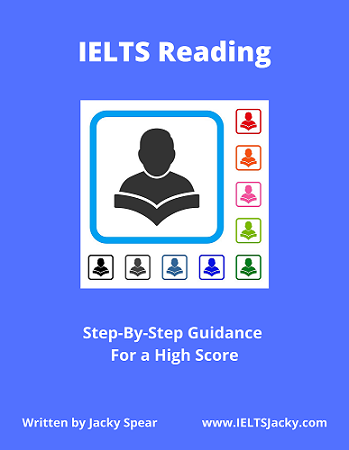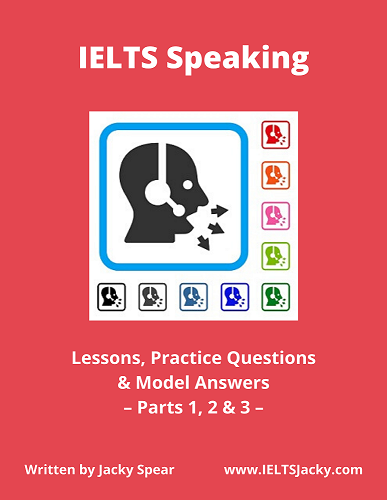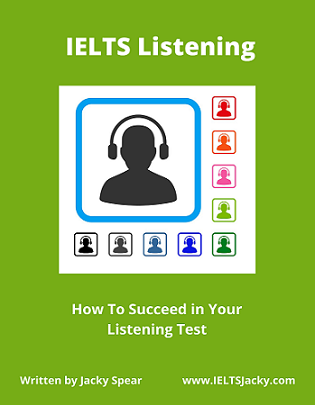IELTS Reading
Multiple Choice Questions
Multiple choice questions appear regularly in both the Academic and General IELTS Reading tests. They are fairly simple to complete but it’s easy to get tricked into picking the wrong answer.
The information and strategy on this page will help you to avoid common errors and to gain high marks. They will also save you time in your test.
Here’s what’s included:
- Explanation of this question type
- Key tips
- The strategy
- Examples from real test papers
- Step-by-step instructions & model answer
The aim of this type of question is to test if you can:
- Understand the main idea of each paragraph
- Scan for specific information
- Use detailed reading to differentiate between several possible answers
The Task
You will be asked to:
1) Read the first half of a sentence, a statement or a question about the text.
2) Choose the most appropriate sentence ending, response or answer from a choice of a number of options (usually 4). Only one is correct although several could appear to be the right one on first reading, so beware.
Here’s an example of how the instructions and questions will be set out. It's part of a question taken from a past test paper.
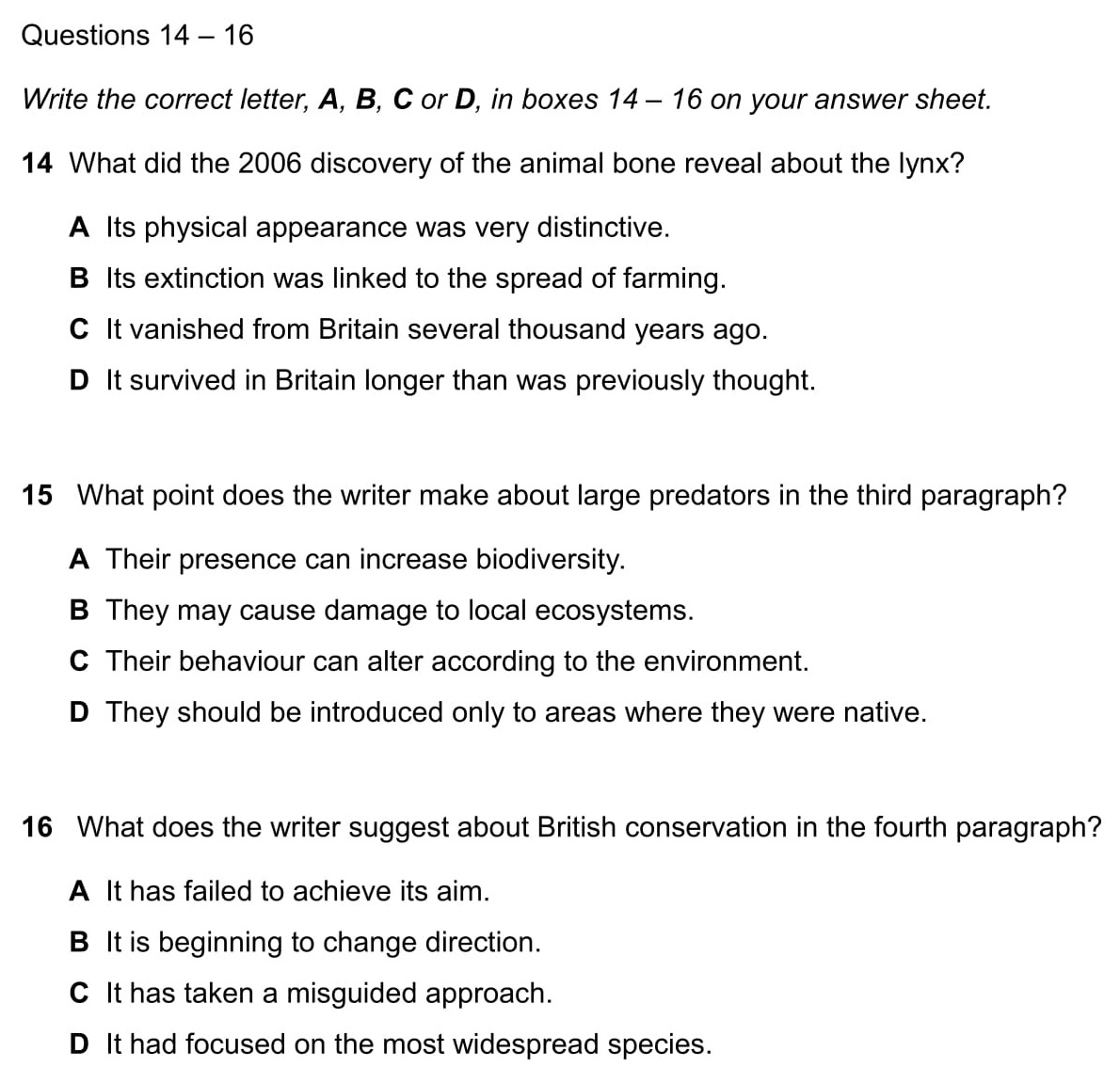
Source: IDP – Past test paper
Key Tips
- Read the questions first. If you do this, you’ll know what you’re looking for when you read the text which will save you loads of time.
- The answers will be in order. It’s very helpful to know that the answers come in order in the text which isn’t the case with all question types. This makes it easier to find them. So, if you’ve found answer 1 in paragraph 1 and answer 2 in paragraph 3, you’ll know that answer 3 won’t be too much further on in the text.
- Read in detail. For some question types, you’ll be mostly skimming and scanning the text for the answers. You’ll need these skills here too but with multiple choice questions, the detail is important.
- Watch out for distractors. Be aware that the test setters love to include ‘distractors’ in the answer options to try and catch you out. A prime example is qualifying words such as every, all, most, a few. They are only small words but they can completely change the meaning of a sentence.
E.g. Everyone who ate the prawn sandwiches at the party was ill.
Most people who ate the prawn sandwiches at the party were ill.
- Don’t leave any blank answers. If you really can’t decide which answer is right, then guess. There’s at least a chance that you’ll guess correctly and get the mark. If you don’t put an answer, the question will be marked ‘wrong’ by the examiner.
False Answers
It’s also useful to know the types of incorrect answers that might be included. Be alert for answers that give:
1) Almost the correct information. (Watch out for those distractors.)
2)The opposite information. (It’s easy to be fooled by these.)
3) Information that’s included in the same paragraph as the true answer but not relevant to the question.
4) Information related to the question which is not included in the text.
Strategy For Answering Multiple
Choice Questions
I’ll show you how to apply this strategy in the example below but first, you need to understand it. Follow these steps.
1) Read the questions
Carefully read the questions. Don’t worry if there are words you don’t understand. If they appear in the text, you may be able to work them out in context. Alternatively, synonyms that you do understand may have been used.
If unfamiliar words appear in incorrect answer options, they don’t matter so much, although you’ll need to make an educated guess at them in order to eliminate the answer.
2) Skim read the text
On this first reading of the text, you are aiming to get just the general meaning.
3) Identify key words
Return to the questions and underline key words in them. These will help you find the location of the correct answer in the text. I’ve underlined them in question 1 below as an example.
This is question 1 from the sample test we'll be working on in a minute.
In the text, synonyms will almost certainly be used for some of them, so think about what these might be as you pick out the key words.

4) Think about meaning
Your other task while looking at the answer options is to try and work out the difference in meaning between them. Two may be very similar. Don’t spend too much time on this but doing it will save you precious minutes in the next step.
5) Predict the correct answer
From your general understanding of the text, you may be able to make a reasonable prediction of the right answer to some of the questions. Put a mark next to your prediction in pencil. You may not be right, but this will help you to narrow down the options.
6) Read the text again
Now re-read the text a paragraph at
a time, particularly scanning for the key words you identified and likely
synonyms. Remember that the answers will be in order so you can expect the
first one to be in paragraphs 1 or 2.
In our sample test paper, the first question helpfully states that the answer is in paragraph 1:
1 In paragraph one, the writer suggests that companies could consider
Once you’ve located the section of text containing the answer, read in detail to fully understand it. Now go back and read the answer options again.
Usually, one or two options will clearly be wrong. Cross them out to eliminate them once you are sure they’re incorrect.
Continue to study the detail in the remaining answers until you've identified the right one.
If one answer jumps out at you as obviously correct, double-check it in case the examiner has succeeded in tricking you in the way I suggested in my key tips. It’s also worth going through the process of eliminate the other answers before finally deciding just to be sure.
7) Deciding between similar answers
It’s common to end up with two very
similar answer options that it’s difficult to decide between. In this case,
you need to study them in even more detail to identify the difference.
First, write them out one under the other unless they already appear like this on the sheet.
Here are a couple of tactics you can then use to compare them:
- Paraphrase each one in your own words.
- Identify distractors such as qualifying words that give them different meanings.
- Compare keywords and synonyms between them and with the question.
8) Move on
Time will
always be against you. If you get really stuck with an answer, you’ll need to
take an educated guess so you at least write something on the
answer paper. If you’re down to two possible answers then you have a 50% chance
of picking the correct one.
Do this and keep moving on through the test.
The more you practice your general reading skills and this strategy for answering multiple choice questions, the quicker you’ll get and the easier they’ll become.
Use all the information, tips and strategies on the pages in the menu below.
Example with answers
This question is from a past IELTS Reading test paper taken from the official IELTS website, www.ielts.org. The passage is just a part of the full text used the exam. In the real
test, a longer version appeared and it had several different types of questions
set on it.
Before checking the answers, you might want to try answering it yourself for practice. When you’ve completed the task, read my notes below on how I found the answers. They include lots more tips to help you with multiple choice questions.
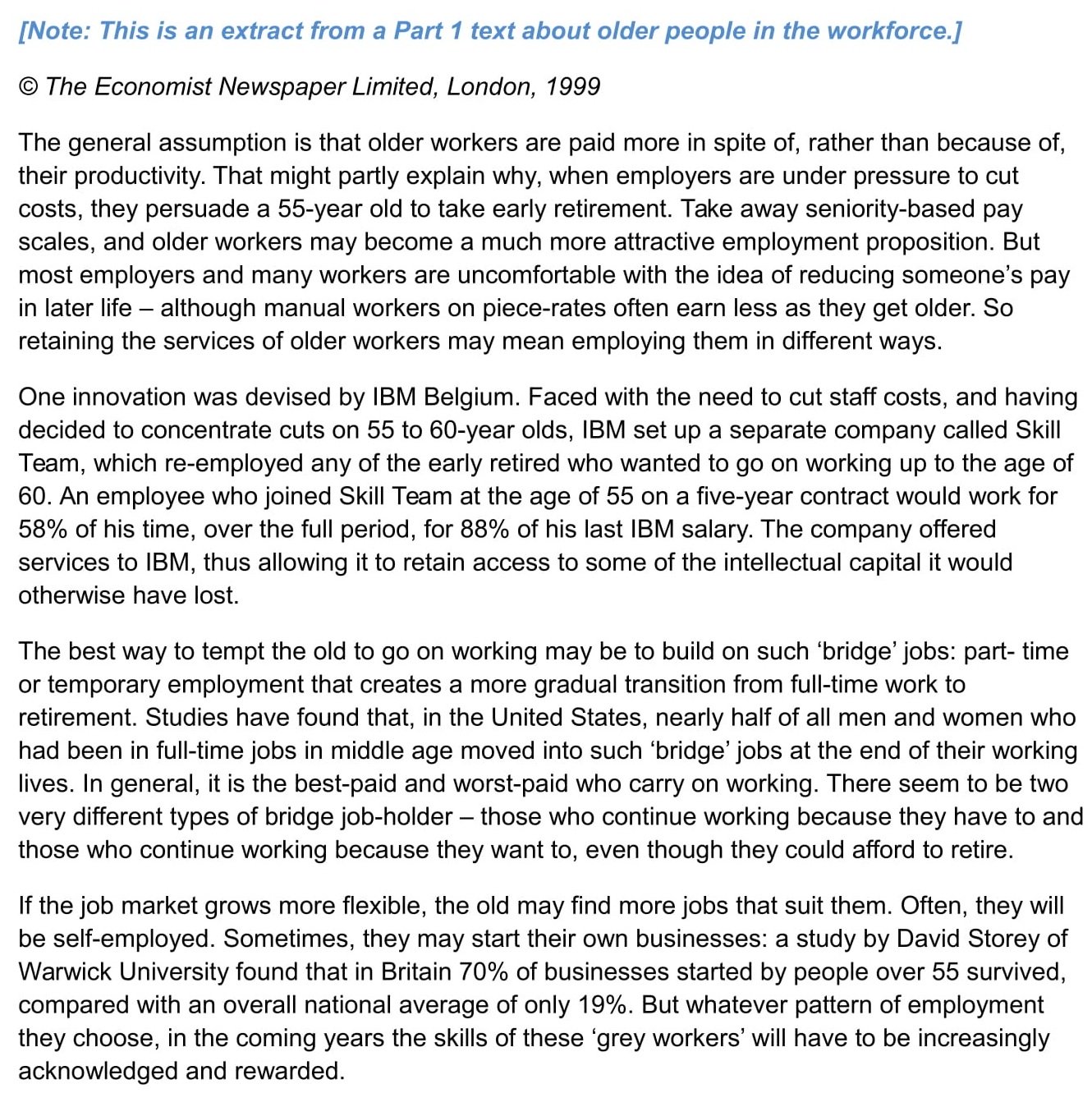
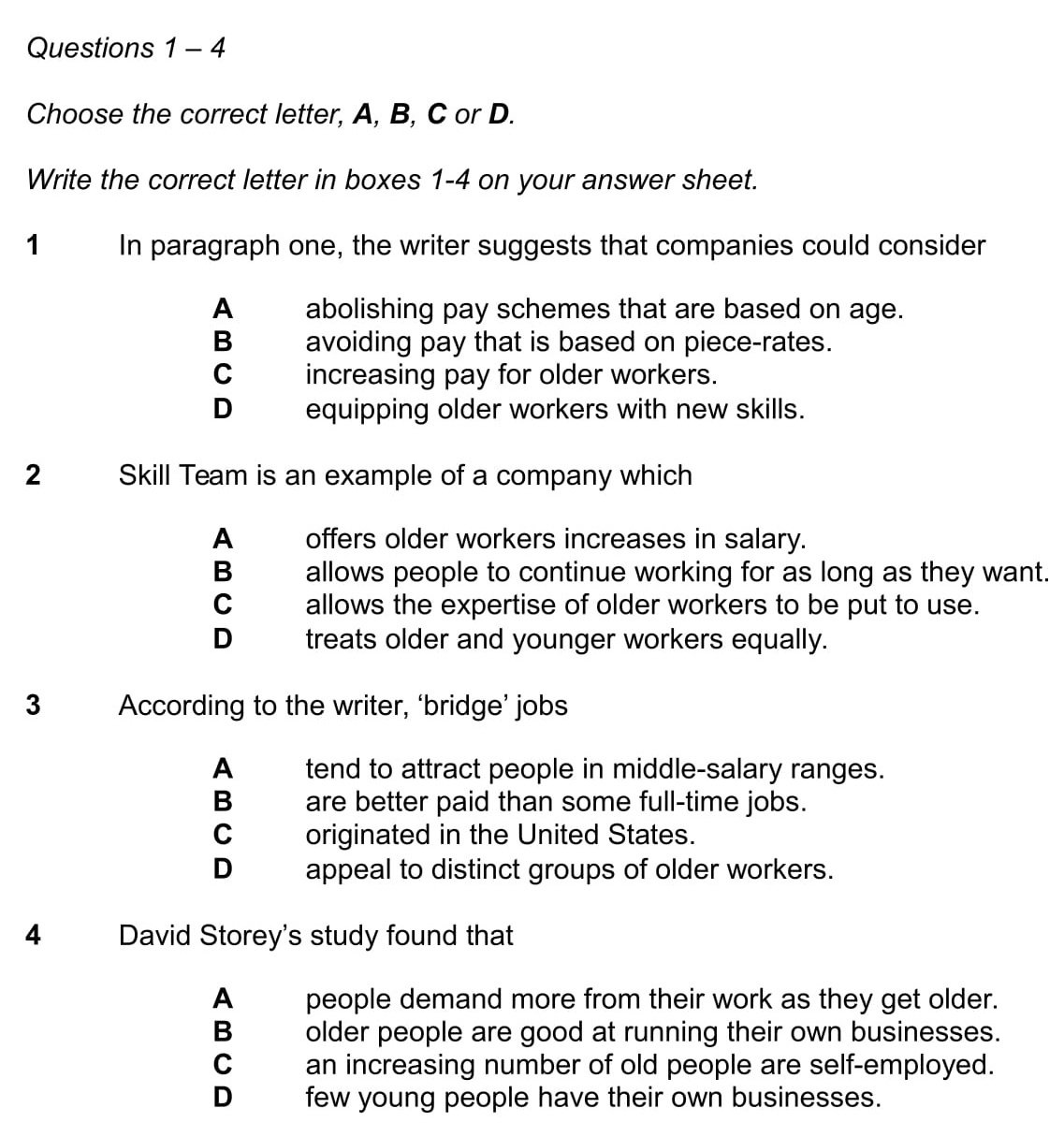
Click this link for a downloadable PDF of the question - Older People in the Workforce
Notes on how I answered the questions
1) First, I read each of the sentences and their four
possible endings to get a general idea of the information they contain.
Next, I skim read the text, again to get the general meaning. I then go to question 1 and underline key words in it.
1
In paragraph one, the writer suggests that companies could consider
A abolishing pay schemes that are based on age.
B avoiding pay that is based on piece-rates.
C increasing pay for older workers.
D equipping older workers with new skills.
I notice that three of the options have the key word ‘pay’ in them so I scan for this first. Since the answers will be in order in the text, I expect this answer to be fairly near the beginning of the passage so concentrate on paragraph 1 to start with.
The general assumption is that older workers are paid more in spite of, rather than because of, their productivity. That might partly explain why, when employers are under pressure to cut costs, they persuade a 55-year old to take early retirement. Take away seniority-based pay scales, and older workers may become a much more attractive employment proposition. But most employers and many workers are uncomfortable with the idea of reducing someone’s pay in later life – although manual workers on piece-rates often earn less as they get older. So retaining the services of older workers may mean employing them in different ways.
‘Pay’ appears
twice. I highlight it. I’m pretty sure that the answer will be in this
paragraph so now scan for the other key words I’ve selected – abolishing,
avoiding, increasing and equipping – or obvious synonyms.
I don’t immediately spot any, so read in detail to try and find the information I need, paying particular attention to the sentences in the text with the word ‘pay’ in.
I identify a sentence that looks promising. It contains the words ‘take away‘ which are a synonym of ‘abolish’, the key word I’ve underlined in option A. The sentence reads,
Take away seniority-based pay scales, and older workers may become a much more attractive employment proposition.
I look at question 1 again to check if the information in the text and answer option A match.
A abolishing pay schemes that are based on age.
They do seem to.
I re-read and evaluate the other option answers. B and C are definitely not a match with the text.
I briefly consider D, as it’s a possible match to the last sentence in the paragraph.
D equipping older workers with new skills.
So retaining the services of older workers may mean employing them in different ways.
However, I decide that ‘equipping older workers with new skills’, is not the same as ‘employing them in different ways’. So, the correct answer must be option A.
Answer: 1 A
2) I move on to question 2.
2
Skill
Team is an example of a company which
A offers older workers increases in salary.
B allows people to continue working for as long as they want.
C allows the expertise of older workers to be put to use.
D treats older and younger workers equally.
I scan for ‘Skill Team’ the company mentioned in the sentence, starting from the location of the last answer. It appears twice in the second paragraph so this is where the answer will be.
One innovation was devised by IBM Belgium. Faced with the need
to cut staff costs, and having decided to concentrate cuts on 55 to 60-year
olds, IBM set up a separate company called Skill Team, which re-employed any of the
early retired who wanted to go on working up to the age of 60. An employee who
joined Skill Team
at the age of 55 on a five-year contract would work for 58% of his time, over
the full period, for 88% of his last IBM salary. The company offered services
to IBM, thus allowing it to retain access to some of the intellectual
capital it would otherwise have lost.
There are no obvious key words to scan for in the 4 options sentence endings.
My strategy this time is to carefully read the options and try to understand the information in each of them and also to underline the word or phrase in each that gives the key information that I need to try and match with the text.
I then read paragraph 2 in detail, looking out for matching ideas.
I quickly discount A, B and D as there is no information to support any of these statements. The answer must, therefore, be C.
Answer: 2 C
The matching information for option C is hidden in paraphrasing but can be found in the final phrase of the paragraph, which reads:
....allowing it to retain access to some of the intellectual capital it would otherwise have lost.
The synonym of ‘expertise’ used in the text is ‘intellectual capital’. It’s quite likely you won’t know this, but you’ll still be able to select the correct answer simply by eliminating the rest as clearly incorrect.
3) Now for question 3.
3
According
to the writer, ‘bridge’ jobs
A tend to attract people in middle-salary ranges.
B are better paid than some full-time jobs.
C originated in the United States.
D appeal to distinct groups of older workers.
I scan for ‘bridge’ jobs. Again, since the answers will come in order in the text, I scan from the location of the last answer. It appears 3 times in paragraph 3 so this is where the answer will be.
The best way to tempt the old to go on working may be to build on such ‘bridge’ jobs: part-time or temporary employment that creates a more gradual transition from full-time work to retirement. Studies have found that, in the United States, nearly half of all men and women who had been in full-time jobs in middle age moved into such ‘bridge’ jobs at the end of their working lives. In general, it is the best-paid and worst-paid who carry on working. There seem to be two very different types of bridge job-holder – those who continue working because they have to and those who continue working because they want to, even though they could afford to retire.
As with the previous question, I carefully read the options and try to understand the information in each of them. I also underline the word or phrase in each that gives the key information that I need to try and match with the text.
I then read paragraph 3 in detail, looking out for matching ideas.
I spot ‘United States’ in the text so read that sentence again to check if the information matches option C which also has ‘United States’ in it. The text states that a study was carried out in the United States while option C says that ‘bridge’ jobs originated there. The information does not match so I can discount option C.
Also, there’s no information in the paragraph about how much people are paid to do ‘bridge’ jobs, so I cross through option B as well.
I can now see that the answer must be in the last two sentences of the paragraph. I’ve already discounted the second sentence about the study in the United States and the first sentence just explains what a ‘bridge’ job is.
I re-read the remaining options, A and D, then carefully read the last two sentences of the paragraph.
A tend to attract people in middle-salary ranges.
D appeal to distinct groups of older workers.
In general, it is the best-paid and worst-paid who carry on working. There seem to be two very different types of bridge job-holder – those who continue working because they have to and those who continue working because they want to, even though they could afford to retire.
The text mentions two types of workers who generally continue working – the best-paid and worst-paid. There is no mention of ‘people in middle-salary ranges’, so option A is not correct.
That just leaves me with option D. Whilst the information in this statement is paraphrased, it clearly matches the text so is the right answer.
Answer: 3 D
As you can see, finding the correct match is often a process of eliminating the other options.
4) I move on to the final question.
4
David
Storey’s study found that
A people demand more from their work as they get older.
B older people are good at running their own businesses.
C an increasing number of old people are self-employed.
D few young people have their own businesses.
I scan for 'David Storey'. It’s always good to have a name to scan for as it will be easy to find. I find it in the last paragraph.
If the job market grows more flexible, the old may find more jobs that suit them. Often, they will be self-employed. Sometimes, they may start their own businesses: a study by David Storey of Warwick University found that in Britain 70% of businesses started by people over 55 survived, compared with an overall national average of only 19%. But whatever pattern of employment they choose, in the coming years the skills of these ‘grey workers’ will have to be increasingly acknowledged and rewarded.
As before, I carefully read the options and underline the word or phrase that highlight ideas I need to look for in the text. I then read the text in detail.
This is one of those questions where it’s easy to get caught out as there’s information in the paragraph relating to several of the possible answers, especially about self-employment and owning a business.
I need to be sure that I focus only on what David Storey’s study found out, which is that in Britain,
‘70% of businesses started by people over 55 survived, compared with an overall national average of only 19%’.
I re-read
the options one by one to see which is the best fit. It’s option B, ‘older people are good at
running their own businesses’. There’s some interpretation needed here but this
is the only option that matches the information in the sentence.
The answer is 4 B.
And that’s the whole question completed.
Answers
1 A abolishing pay schemes that are based on age
2 C allows the expertise of older workers to be put to use
3 D appeal to distinct groups of older workers
4 B older people are good at running their own business
I hope you’ve found these extra notes helpful. Now use this strategy and all the tips to practice answering multiple choice questions from past IELTS Reading test papers. This practice will quickly improve both your skills and your level of confidence.
Want to watch the video of this page? Click here.
Like this page?
Lessons On All Question Types
For more sample questions with step-by-step instructions, see the IELTS Reading menu page.
More Reading Test Pages
IELTS Reading Test – Understand the format, question types & marking system & know what skills are assessed. Also learn success strategies, key reading skills & discover top tips.
IELTS Reading Skills – Master the skills of skimming, scanning & detailed reading. Understand the importance of topic sentences & how to use context for meaning & unfamiliar words.
Top 7 IELTS Reading Tips – Each tip will take you a step closer to the high score you want. They are the key to top marks in your test.
9 More Tips For IELTS Reading – Learn valuable practice techniques & discover a secret that may gain you extra marks.
IELTS Reading Practice – Discover the top 5 things you must do to prepare for your reading test.
How to Complete the IELTS Reading Test in 60 Minutes – Top 6 Recommendations.
IELTS Academic Reading – Why you should take IELTS Academic Reading, test format, text types &
sample tests.
IELTS General Reading – Why you should take IELTS General Reading, test format, text types & sample tests.
Reading Practice Samples – Short activities to improve your reading skills & help you learn topic vocabulary.
Answers
1 A abolishing pay schemes that are based on age.
2 C allows the expertise of older workers to be put to use.



